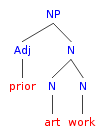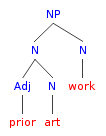April 23, 2006
Prior artwork
It must be hard to be a copy editor. I especially admire the ability to focus effectively on the form as opposed to the content of texts. Distracted by meaning, I tend to read right past flocks of missing function words, wrong inflections, and even derivational substitutions like "substitution" for "substituted". For catching the many errors in my Language Log posts, I rely on the kindness of readers, since my attitude towards blogging is similar to the "first rule of Italian driving" explained by Raul Julia (as Franco) in the movie Gumball Rally: "[Franco rips off his rear-view mirror and throws it out of the car] What's-a behind me is not important."
But copy editors also need to understand the content of the stuff they're working on. The hardest part of this, I think, is understanding (and respecting) the use of ordinary words as terms of art. And of course it's the failures that readers notice, just as I noticed a mistake in John Markoff's 4/16/2006 NYT story "In Silicon Valley, a Man Without a Patent".
Markoff's story describes Geoff Goodfellow's 1982 efforts to start a wireless email service. The news hook is the recent $612.5-million payout from the Blackberry company Research in Motion to NTP, the holders of apparently bogus patents on wireless email that were granted to Thomas J. Campana Jr. a decade after the (economic) failure of Goodfellow's attempt.
The editorial mistake is a missing space:
"I think there is a potential ethics issue," said Mark A. Lemley, a Stanford professor who specializes in patent law. "The basic key is the attorneys have the obligation to disclose everything they know about his prior artwork and make him available as a fact witness." [emphasis added]
The spelling "prior artwork" implies a constituent structure like this

and a reference to the compound word artwork, defined by the AHD as
1. Work in the graphic or plastic arts, especially small handmade decorative or artistic objects. 2. An illustrative and decorative element, such as a line drawing or photograph, used in a printed work, such as a book.
But Professor Lemley is not talking about decorative or artistic objects or illustrative and decorative elements. He's talking about the fact that Goodfellow's work (and publications) in the 1980s are "prior art" in the legal sense, perhaps invalidating NTP's patents, which NTP's lawyers would be ethically required to disclose. As Merriam-Webster's Dictionary of Law explains, the legal term "prior art" refers to
: the processes, devices, and modes of achieving the end of an alleged invention that were known or knowable by due diligence before and at the date of the invention
also
: the knowledge or description of such processes, devices, or modes (used chiefly in patent law)
Thus Lemley meant "prior art" to be a compound word used to modify "work", or at least combined into a higher-level compound with "work", in a structure like this one:

Goodfellow's work may well have been "prior art" relative to the NTP patents, but Goodfellow himself never attempted to patent the idea of wireless email, because of a different concept in patent law (and common sense notions of equity as well): obviousness. Goodfellow explains:
"You don't patent the obvious," he said during a recent interview. "The way you compete is to build something that is faster, better, cheaper. You don't lock your ideas up in a patent and rest on your laurels."
In principle, the U.S. Patent and Trademark Office agrees:
Even if the subject matter sought to be patented is not exactly shown by the prior art, and involves one or more differences over the most nearly similar thing already known, a patent may still be refused if the differences would be obvious. The subject matter sought to be patented must be sufficiently different from what has been used or described before that it may be said to be nonobvious to a person having ordinary skill in the area of technology related to the invention.
However, in practice, the question of what is "nonobvious to a person having ordinary skill" is a tricky one. From Goodfellow's point of view (which I share), once you have email, then the simple idea of accessing your email via a different kind of device is obvious. Unfortunately, the USPTO (or rather, its examiners) have gone very far in the direction of allowing "inventors" to lock up whole areas of technological innovation by simply running through the cross-product of services and devices and communications channels, and patenting the idea of offering service X on device Y via channel Z -- often without any concrete contribution to the technical problems that may be involved. This is not invention, it's blind combinatorics.
Anyhow, my guess is that Markoff transcribed Lemley's phrase correctly, as "prior art work" (or "prior-art work"?), but a copy editor mechanically applied a rule about which compounds are to be written solid, and substituted "prior artwork", violating the intended constituency. As evidence that this spelling is a general policy when art and work really form a unit, I note that the NYT index finds (since 1981) 4,732 examples of "artwork" vs. 625 examples of "art work". Similarly, Google news this morning has 5,220 instances of "artwork" vs. 441 of "art work".
Posted by Mark Liberman at April 23, 2006 10:12 AM